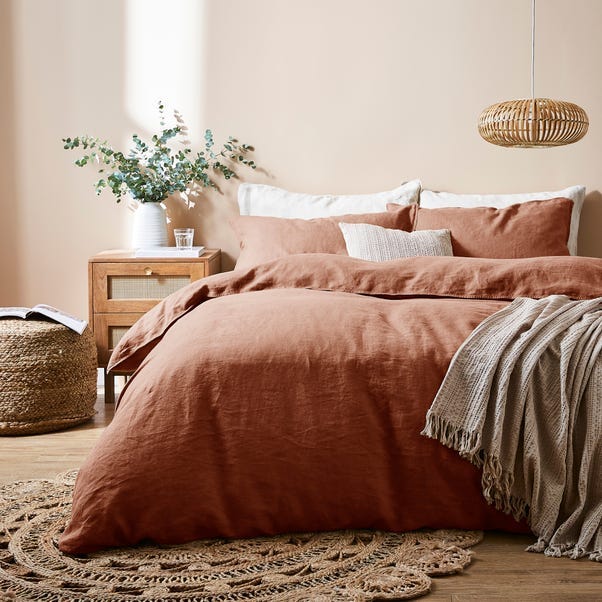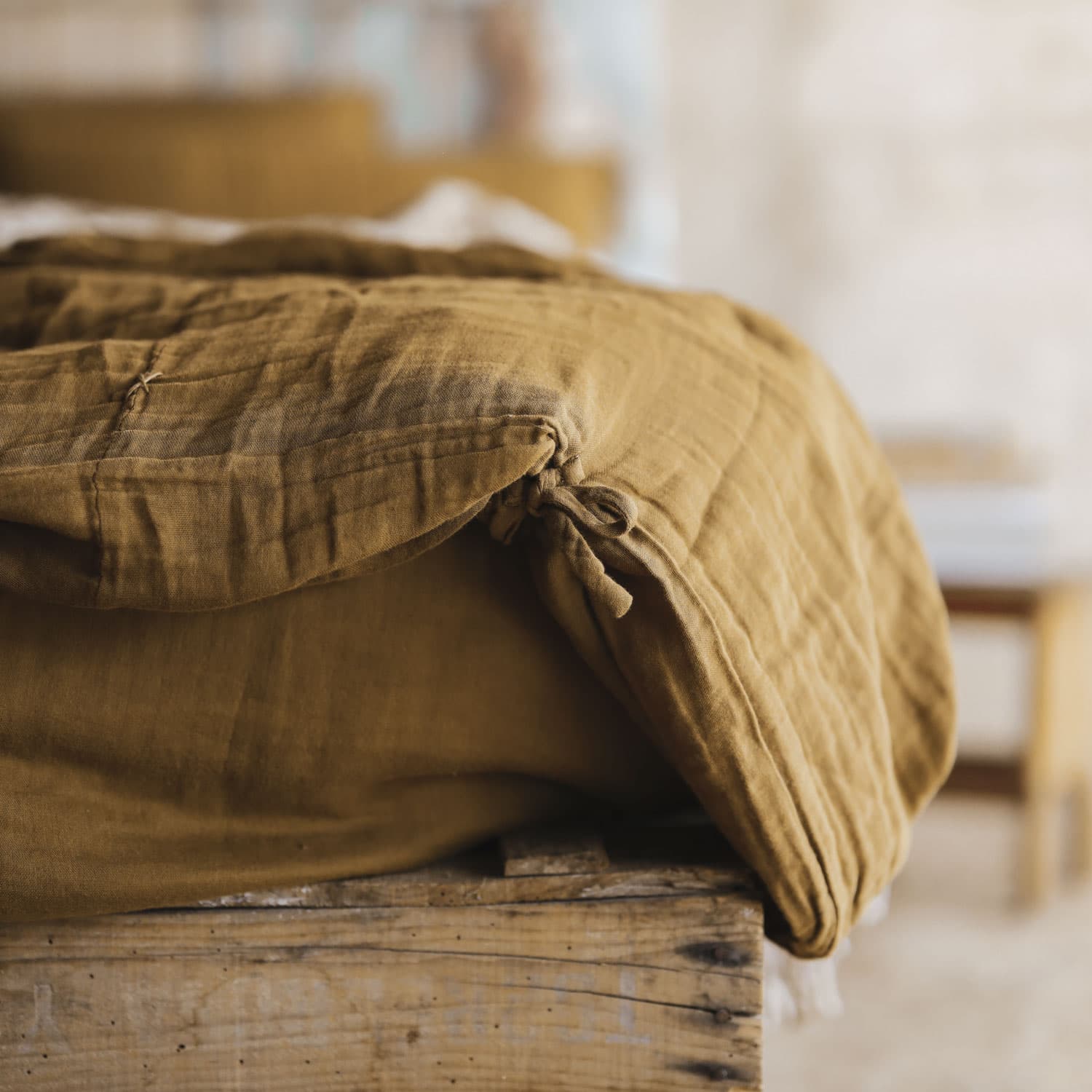Australia Linen vs Cotton: Which Is Better for Summer Wear?
Wiki Article
Recognizing Linen: The Eco-Friendly Alternative for Comfortable Living
When you think of environment-friendly textiles, bed linen usually sticks out for its unique top qualities. This natural fabric, made from the flax plant, offers both convenience and sustainability. Its exceptional buildings make it a suitable choice for cozy climate and lasting use. What genuinely sets bed linen apart from various other materials? Understanding its beginnings and advantages can change how you watch home textiles. Allow's check out the interesting world of linen additionally.The Beginnings of Linen: From Flax to Textile

Linen, among the earliest textiles known to humankind, has a remarkable journey that starts with the modest flax plant. You could be amazed to find out that this plant grows in awesome climates, growing in areas like Europe and parts of Asia. When collected, the flax stalks undertake a procedure called retting, where they're saturated to separate the fibers from the woody parts. After retting, the fibers are combed and spun right into yarn, ready for weaving.
When you see bed linen fabric, you're witnessing centuries of workmanship. Linen has been treasured for its natural appearance and feel, making it a favorite for every little thing from garments to home textiles.
The Distinct Properties of Bed Linen
One of the standout functions of this remarkable textile is its breathability. When you wear bed linen, you'll see just how it allows air to distribute, maintaining you cool down on warm days. This property makes it a best choice for summer garments and sheets.Linen likewise boasts phenomenal moisture-wicking capacities, pulling sweat away from your skin and permitting it to vaporize swiftly. You will not feel clammy, also in moist problems. Additionally, bed linen is durable, often becoming softer and a lot more comfy with each laundry, which implies it can stand the test of time in your wardrobe.
Another one-of-a-kind aspect is its all-natural texture; the mild irregularities offer linen a character that boosts your style. Plus, it stands up to wrinkles better than many other materials, so you can appreciate a kicked back yet brightened look without much effort. Welcome linen, and you'll value its comfort and one-of-a-kind charm.
Ecological Benefits of Bed Linen
When you choose bed linen, you're not just choosing a beautiful textile; you're also supporting lasting manufacturing practices. Linen's compostable and eco-friendly nature makes it a smart choice for the atmosphere. And also, it calls for considerably much less water to create compared to other textiles, aiding preserve this valuable resource.Sustainable Manufacturing Practices
Although many fabrics have significant environmental effects, bed linen stands out due to its sustainable production practices. When you pick linen, you're opting for a textile made from the flax plant, which calls for very little water and pesticides.Linen manufacturing is usually much less energy-intensive contrasted to other fabrics, as it includes all-natural procedures as opposed to synthetic treatments. By sustaining bed linen, you're adding to a much more lasting fabric industry that focuses on environmentally friendly techniques. Selecting linen not just enhances your convenience yet also straightens your values with ecological duty.
Naturally degradable and Compostable Product
Linen's environmentally friendly nature expands beyond its sustainable manufacturing; it's compostable and additionally biodegradable, making it an excellent option for environmentally mindful customers. When you choose bed linen items, you're selecting products that damage down naturally, returning nutrients to the earth. This implies that at the end of their life cycle, your bed linen items will not add to landfill waste. Instead, they can decay safely, minimizing your ecological impact. Composting bed linen can enrich dirt, advertising healthy and balanced plant growth. By incorporating linen into your home, you're not just enjoying its comfort and toughness; you're also aiding and sustaining eco-friendly practices create a healthier planet. Embrace linen, and really feel great regarding your options for the environment.Reduced Water Intake
One of the standout benefits of bed linen is its low water usage throughout farming. Unlike cotton, which requires considerable watering, linen's flax plant prospers on minimal water, making it a more sustainable selection. You'll value understanding that for every heap of linen generated, significantly much less water is needed compared to several other fabrics.Linen vs. Other Fabrics: A Contrast
When you contrast linen to various other textiles, you'll notice its premium breathability and comfort, making it best for cozy climate. And also, bed linen stands out for its sturdiness and longevity, usually outlasting numerous frequently utilized products. As you consider your options, the ecological influence of each textile will certainly likewise play a necessary function in your decision.Breathability and Convenience
Breathability is a crucial element in selecting materials for convenience, especially in warm weather condition. Linen sticks out amongst products for its impressive ability to allow air circulation. Unlike synthetic materials, which can catch warm and moisture, linen's all-natural fibers wick away sweat, maintaining you completely dry and trendy. When you put on bed linen, you'll discover how it feels light against your skin, enhancing your comfort during hot days.Cotton is frequently praised for its soft qualities, but it doesn't match bed linen's breathability. If you focus on comfort, especially in summer, linen needs to be your go-to choice.
Toughness and Durability
While several materials provide varying levels of durability, linen truly masters longevity, making it a sensible financial investment for your wardrobe. Unlike cotton or artificial materials that might wear quickly, linen gets more powerful with each laundry. Its natural fibers stand up to fading and fraying, ensuring your garments look wonderful over time. You'll discover that linen's breathable nature additionally decreases wear from sweat and dampness, which can harm other textiles. Plus, its capacity to endure heats implies it will not diminish conveniently in the dryer. When you pick linen, you're opting for a durable fabric that can manage everyday usage while keeping its appeal. Believe me, your lasting investment in bed linen will certainly pay off with years of fashionable, comfortable wear.Environmental Influence Comparison
Although numerous fabrics contribute to ecological concerns, bed linen sticks out for its environmentally friendly high qualities. Unlike cotton, which needs substantial water resources and chemicals, bed linen is made from flax, a plant that prospers on marginal Linen water and requires less chemicals. This implies you can feel good concerning your selection while minimizing your carbon impact.When contrasted to artificial fabrics like polyester, bed linen's biodegradability shines. While polyester can take centuries to decay, linen breaks down naturally, returning nutrients to the soil.
Picking linen not just advertises sustainable farming techniques but additionally sustains a healthier world. By opting for bed linen over conventional materials, you're making a conscious choice that benefits both your convenience and the setting.
Caring for Your Linen Textiles
To assure your linen textiles remain in terrific condition, you'll wish to follow some straightforward care standards. Wash your bed linen in cold water on a mild cycle to prevent it from reducing or losing its form. Avoid making use of bleach, as it can damage the fibers. Rather, go with a light detergent that's without rough chemicals.When it pertains to drying, air drying is ideal. Choose a reduced warmth setting and remove the things while they're still somewhat damp to reduce wrinkles if you make use of a clothes dryer. Iron the bed linen while it's still damp for less complicated handling, or steam it to keep it looking crisp.
For storage, maintain your linen in a cool, dry location. Stay clear of direct sunshine to avoid fading. With these simple practices, your bed linen fabrics will certainly keep their beauty and last for years, making them a sustainable addition to your way of life.
Integrating Bed Linen Into Your Home Design
Taking care of your linen textiles not only protects their top quality yet additionally opens a globe of opportunities for including them right into your home décor. You can start small by adding linen throw pillows to your couch, immediately boosting the room with structure and warmth. Think about bed linen drapes that filter sunlight magnificently, producing a soft, airy atmosphere in any kind of area.For an extra rustic look, try making use of bed linen tablecloths or runners throughout dishes; they include a classy touch and are easy to clean. If you're really feeling adventurous, mix and match different bed linen colors and patterns to produce a special, layered impact.
Don't ignore linen blankets-- drape one over a chair or your bed for a welcoming feel. By attentively integrating linen right into your design, you boost both convenience and style, making your home a calm hideaway.
The Future of Bed Linen in Sustainable Living
As customers increasingly focus on sustainability, bed linen emerges as a frontrunner in eco-friendly fabrics. Its production makes use of less water and pesticides contrasted to traditional cotton, making it a more environmentally responsible option. As you look towards a sustainable future, incorporating linen right into your closet and home can considerably reduce your carbon footprint.Cutting-edge brands are currently concentrating on sustainable methods, from utilizing natural flax to carrying out circular economy concepts. You'll locate that bed linen's resilience implies it lasts longer, decreasing the need for constant substitutes.
Additionally, as even more individuals welcome minimalist way of livings, linen's ageless appeal and adaptability will certainly keep it relevant. By choosing linen, you're not just selecting comfort; you're also sustaining lasting practices.
In the upcoming years, the demand for linen is expected to grow, solidifying its place in a more eco-conscious globe. Think about making bed linen a staple in your sustainable living trip.
Frequently Asked Questions
Is Linen Suitable for People With Allergies?
Yes, linen's natural fibers are hypoallergenic, making it suitable for people with allergies. Its breathable nature helps in reducing wetness and germs accumulation, adding to a healthier sleeping setting. You'll likely locate it comfy and secure.Can Linen Be Colored Conveniently?
Yes, you can dye linen easily. Its natural fibers absorb dyes well, permitting vivid shades. Just make sure you make use of the right color type and follow proper techniques to achieve the desired outcomes without harming the material.Exactly How Does Linen Contrast in Longevity to Cotton?

What Weight of Linen Is Ideal for Summer Clothing?
For summertime garments, light-weight bed linen around 4 to 5 ounces per lawn is excellent. It maintains you awesome, breathable, and comfortable in hot weather (Linen Australia). You'll appreciate how it drapes and steps with look what i found you effortlessly
Can Linen Be Utilized for Outdoor Furnishings?
Yes, you description can use linen for outdoor furniture. It's breathable and durable, making it an excellent option for cozy climate. Just be certain to pick a treated variation to hold up against the elements and keep its look.Final thought
Including bed linen right into your life not only boosts your comfort yet also sustains a much more lasting future. With its special residential or commercial properties and very little environmental influence, linen is a smart option for your home décor and lifestyle.Linen's compostable and eco-friendly nature makes it a clever option for the setting. By incorporating bed linen into your home, you're not simply appreciating its comfort and resilience; you're likewise assisting and sustaining eco-friendly methods produce a much healthier planet. The Future of Linen in Sustainable Living.

Report this wiki page